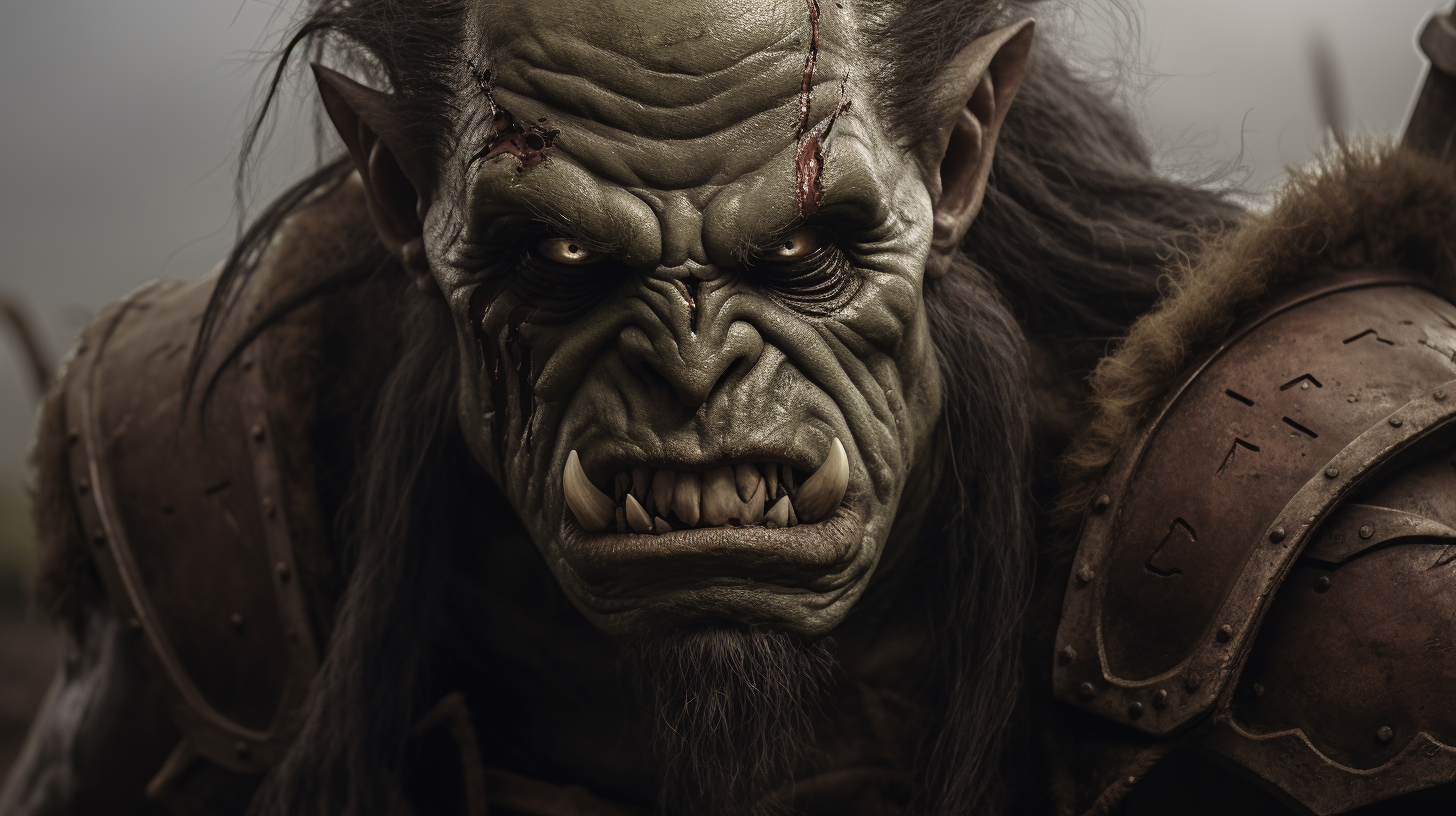
Preface
In the annals of Eldergrove’s tangled history, a formidable tapestry of culture and survival, one cannot overlook the enigmatic presence of The Lost Tribe. Nestled within the heart of this ancient forest, a society of orcs has taken root, upending both conventional orcish dogma and the limitations those who see them through eyes of ignorance. This monograph endeavors to peel back the layers of this unique tribe, piecing together the fragments of lore and legend that define their identity.
How upended, you may ask? They are governed not by the barking males of the species, but by the self stylized “Matriarks.” Eschewing the chaotic nature of traditional orcish society, they follow a rigorous code religiously. And speaking of religion, they not only shun the orc pantheon of Gruumsh, but believe any story of the one-eyed god to be fairy tales meant to weaken the tribe. But, most incredibly - and, as I will kindly do throughout, I tell you this for your own safety, you’re best not to say it this way should you ever converse with something other than the blade of a tribe member - the Lost Tribe embraces member who are not orcs. On this last point, I can’t help but add: you would be hard pressed to not think they were orcs.
Ever since I first heard tale of this tribe late one night in The Whispering Willow, my mind has been fixed on one question: how could this upending occur?
My belief is that The Lost Tribe’s dramatic origins forced the tribe to evolve.
First, some years ago the drow of the under-mountain decided that no other races should cohabitate with their vile selves. The drow, demonstrating that intelligence is no guarantee of civility, systematically wiped out countless orcish tribes and other residents of the hill. There are much more unkind words to apply to such a “war” that I will omit. The tribe calls this event The Crucible.
The drow’s utter destruction of the tribe leadership and warrior-cast of left the tribe both leaderless and gave them stark evidence that their traditional notions of strength were, to apply the strongest of orcish insults, weak. The handful of tribe members that remained were forced to flee.
Having fled south from the Elf’s Walls to the Elderwood, being a tiny minority populace our forest has forced the Lost to evolve core tenants of their society. “Tiny minority” - it’s best not to phrase the Lost as such as I found one night!
I for one, believe it is a an evolution for the better. As a guardian of the Elderwood, I’ve seen many of the towering triangle of the Lost Tribe stand among the tower trees of the wood. To my eyes, the two are indistinguishable.
The Triangle
Within the whispering depths of Eldergrove, a tribe of orcs stands as a testament to resilience and adaptation. Forged by hardship and driven from their mountain homes after a bitter defeat against the genocidal drow of the under-mountain, these orcs are now known as “The Lost Tribe.” 333 in number, they have woven themselves into the fabric of the forest, spreading across enclaves both large and small, emerging as an unexpected union of diverse races and backgrounds.
Matriarchal Evolution
From what I can glean, somewhere around 80 years ago - 84, the more numerological of the tribe will insist - the under-mountain drow’s relentless onslaught upended this tribe’s traditional orcish hierarchy. Most of the male leaders, once the cornerstone of orcish leadership, were either slain or captured by the drow. In the wake of devastation, a matriarchy emerged.
Now, under the mantle of “Lost Matriarks,” the females guide their tribe. At the apex stands the Blood Matriark, embodying both fierce warrior and cunning leader, proving her mettle annually or when challenged.
 Kanak, The First Matriark
Kanak, The First Matriark
Studying the society, culture, and mind of The Lost Tribe is like studying magics of a master illusionist gone mad. Nothing is as it seems, and the mage casting the spell cannot be relied on for a coherent explanation. Proud as they are, a member of the tribe only ever has one reason to explain their nature: strength. Very few will abide inquiry about origins.
However, in a few rare conversations I have all but confirmed my suspicions. Because the fleeing tribe was so lacking in the male members of the species and the shamans who passed down their traditional beliefs, their new society evolved both, I believe, in blood and in brains. As an often repeated saying of The Lost Tribe says: “the enemy’s blade culls the weak, clearing a way for the strong to answer."
And, dear reader, you will delight in knowing that there are many, many sayings of The Lost Tribe. I will share some with you as we go, and have endeavored to collect those I know in an appendix. However, I have counted well over 500 now and am endeavoring to capture them all in a subsequent volume.
The Blood Code
Struggling to survive the aftermath of the drow genocide, and then as immigrants in an unfamiliar realm, The Lost Tribe evolved into lawful society. The necessity to survive led to the crystallization of a strict, unyielding code, The Blood Code. Though it may appear brutal to outsiders, the code is the tribe’s moral compass. This distinction sets them apart from the broader orc religion and culture, further fueling their sense of defiance, pride, and to my belief, strength and adaptability.
The Crucible birthed a strict code that governs every facet of their existence. This code, both brutal and unwavering, anchors them in their collective identity. Every tribe member, from birth, is indoctrinated into the Code’s tenets. The tribe attributes the code’s early inception to their salvation, standing as a defiant testament to their resilience.
The Blood Code of Three Threes TK( this should be in sets of 3 )
- 𐑮𐑃𐑎 𐑎𐑗𐑝𐑊𐑞𐑑𐑗𐑑𐑉𐑊𐑝 (Respect blood, honor the tribe)
- 𐑑𐑎𐑑𐑗𐑇𐑇 𐑃𐑎𐑏𐑑𐑉𐑑𐑒𐑑 (Stand together, forged by annihilation)
- 𐑝𐑠𐑙𐑍𐑕𐑎𐑎 𐑊𐑍𐑎𐑗𐑙𐑃𐑊𐑠 (Give strength, share strength)
- 𐑏𐑑𐑉𐑊𐑝 𐑑𐑑𐑞𐑋𐑑𐑛𐑇𐑗 (Defend honor, wield valor’s blade)
- 𐑞𐑋𐑑𐑛𐑇𐑗 𐑍𐑕𐑍𐑠𐑝𐑊𐑛 (Crush the witless, build strength)
- 𐑃𐑎𐑏𐑑𐑉𐑑𐑒𐑑 𐑎𐑓𐑛𐑏𐑑𐑠𐑎𐑎 (Craft legacy, shape destiny)
- 𐑃𐑎𐑏𐑑𐑉𐑑𐑒𐑑 𐑞𐑉𐑠𐑎𐑛𐑑 (Victory in strength, strength in threes)
- 𐑑𐑗𐑑𐑙𐑎𐑇𐑇 𐑏𐑕𐑍𐑏𐑑𐑞𐑃𐑊𐑠 (Forge the three, steel binds)
- 𐑗𐑑𐑊𐑝 𐑑𐑗𐑑𐑑𐑗𐑑𐑊𐑗 (The Code is strength, eternal strong)
Triumvirates of Governance
 Councils of three, composed of revered orcs, govern the sub-tribes. These councils oversee daily governance, with a higher council above them, beneath the authority of the Blood Matriark. Guided by the Blood Code, the system's simplicity favors clarity and speed, making for swift decisions. The Blood Matriark retains the right to override, challenge, or ignore council decisions, though typically, harmony prevails.
Councils of three, composed of revered orcs, govern the sub-tribes. These councils oversee daily governance, with a higher council above them, beneath the authority of the Blood Matriark. Guided by the Blood Code, the system's simplicity favors clarity and speed, making for swift decisions. The Blood Matriark retains the right to override, challenge, or ignore council decisions, though typically, harmony prevails.
The Triangle of Blood, Unwavering Companionship
Orc of the Lost Tribe are only ever seen in sets of three. This is known as a “Blood Triangle.” Aside from the hidden moments when orcs are ensconced with families, the triangle the smallest group of orcs you’ll ever seen. To see a single orc outside of the confines of an orc camp signifies that something has gone awry.
I have yet to discover when these triangles are formed, but from guarded responses to my queries, they appear to be life-long bonds between the three. Some ritual binds them, and, I suspect, as with all oaths and rituals of The Lost Tribe, an exchange of blood likely takes place. Indeed, the three call each others “Blood Kin” and adopt fanciful names for their group. The rest of the Lost will often refer to triangle, rather than a specific orc.

When you meet them in full splendor, the triangle is a formidable sight — two heavily armored orcs bearing orcish greatswords, each known as a render, accompanied by a third wielding a longsword and an orcish longbow, known as the blood seeker. The later serves as a ranged observer, barking strategic observations, suggesting tactics, and, of course, seeking blood from afar.
Curiously, the Blood Matriark has no triangle. I have yet to discover why.
The Tribe is Blood
Perhaps the most delicate part of my study has been learning about the foundlings role in The Lost Tribe. Common in other societies, a “founding” is a child that has been, well, found by one of the tribe. This may be by accident, though more than you would suppose, it is on the battlefield.
These foundlings are oft not actual orcs. Curiously, they are often children of those the orcs have slain. I have become, well, one does not say “friends” about members of the tribe, but, rather, I have had the chance to speak on multiple occasions with many of these foundlings. Thus far, all but three have been humans. Aside from physical characteristics, they are indistinguishable from the rest of the Lost.
Indeed, the foundlings status appears to be as such to the, if you’ll pardon the phrase, true orcs of the Lost Tribe.
Early on in my study of the Lost when I was a bit more cavalier with my questions, I asked one of the orcs in the Crimson Whisper triangle how one of their points, the human Kelda (the blood seeker), thought of her position biologically in the society. Her silence was captivating, and unnerving. It caught me off guard, and as I tried to recompose myself, I found that Qrald the One Fang, had suddenly hoisted my small halfling frame up eye-to-eye, demanding to know on which trees I would like various parts of brains spread on. It was only with a dramatic braking from Kelda that Qrald set me down.
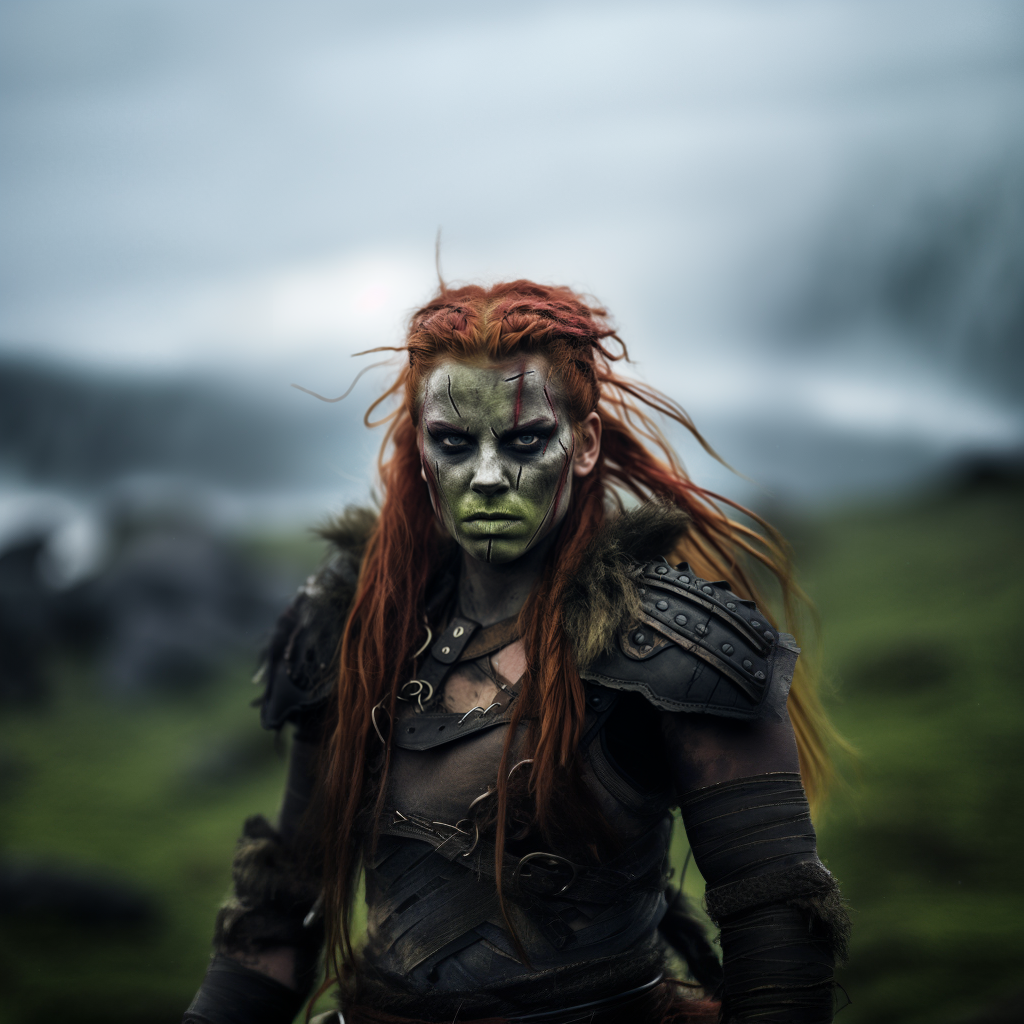
“They do not see what you see,” Kelda said, having shifted from the orcish I had only heard her speak to a rough use of our Common Tonge. She hesitating every so slightly, looking at me with those dull blue eyes of hers, “nor what I can see. They see only orc.” She then proceeded to do something I had never experienced and have yet to experience again: she smiled at me! It was not, I fear, a jovial smile, however. It was then that I noticed that all of her teeth that could be seen has been filed to jagged points, some layered with metal and, thus, pulled into tiny daggers.
After that, dear reader, I learned to never see the distinction myself, least seeing eye-to-eye with a member of the Lost became the last thing I ever saw.
Delicate Diplomacy
The Lost Tribe maintains an uneasy peace with Aurel’s Reach, once embroiled in clashes that have given way to mutual non-interference. Many decades ago, before my arrival in the forest, a rare alignment of threat from across the Sea of Passage saw the Lost align with the popular of Aurel’s Reach in combat.
Lost Tribe orcs venture to the city occasionally, always in threes, causing surprise and caution, but rarely alarm and combat.
Of late, there is a more permanent pretense of The Lost Tribe in Aurel’s Reach. One triangle known as the Matriark’s Voice resides permanently in the city, serving what we would call “diplomats,” a word the Lost don’t seem to have in their vocabulary.
Notable Blood Tribe Members
Blood Matriark Kanak the 3rd
 Kanak the 3rd, descendent of the first is the current Blood Matriark of the tribe. Guided by flames both visceral and metaphorical, she commands with a blazing resolve. Kranark’s rise to power was written in dragonfire—the scalding crucible where she and her triangle fought with the previous Blood Matriark’s against a mighty wyrm that had invaded the tribe’s main camp. Drawing the dragon away from the camp, Kranark’s triangle and the Matriark eventually defeated the creature late into the night. But it was a trial beneath the weeping moon, all but the Blood Matriark and Kranark were killed by the dragon.
Kanak the 3rd, descendent of the first is the current Blood Matriark of the tribe. Guided by flames both visceral and metaphorical, she commands with a blazing resolve. Kranark’s rise to power was written in dragonfire—the scalding crucible where she and her triangle fought with the previous Blood Matriark’s against a mighty wyrm that had invaded the tribe’s main camp. Drawing the dragon away from the camp, Kranark’s triangle and the Matriark eventually defeated the creature late into the night. But it was a trial beneath the weeping moon, all but the Blood Matriark and Kranark were killed by the dragon.
Amidst the still-bleeding dragon’s carcass, seeing her opportunity, Kranark challenged the Blood Matriark. Despite both being severely injured by the dragon fight, Kranark defeated the Matriark to ascend as the new Blood Matriark by code. She has been the longest serving Blood Matriark and is as ruthless as she is devoted to the code and the tribe.
While she may not appear to be the strongest of all orcs, she is the craftiest and wisest of all Lost that I have met. Her intelligence can seem like magic to the other orcs. Paired with with speed and cunning, she is believed indomitable.
The Red Whisper
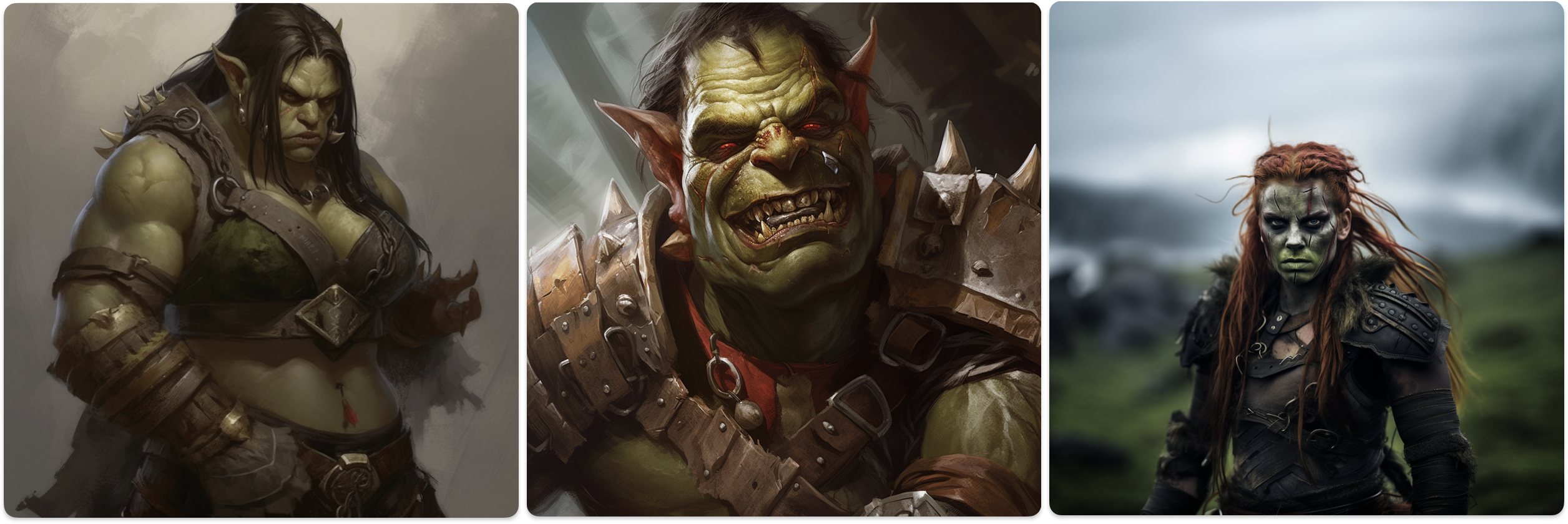 A small “camp” of just one Blood Triangle, Rokar Bloodblade, Qrald the One Fang, and Kelda Shadowarrow patrol the north east forest as the advance watch against drow. Though rare, drow occasionally come up from the under-mountains. Thanks to the Red Whispers, few have survived passage into Elderwood.
A small “camp” of just one Blood Triangle, Rokar Bloodblade, Qrald the One Fang, and Kelda Shadowarrow patrol the north east forest as the advance watch against drow. Though rare, drow occasionally come up from the under-mountains. Thanks to the Red Whispers, few have survived passage into Elderwood.
This trio embodies the tenacious heart of The Lost Tribe. And I’ve learned much about how the tribe works, how it thinks from them:
Fierce Loyalty: Even with their frequent bickering - very frequent bickering - the bond between Kelda, QRald, and Rokar unbreakable. Their mutual trust and reliance on each other are evident in their synchronized movements, non-verbal communication, and shared responsibilities. For the Lost Tribe, loyalty isn’t just a virtue; it’s a way of life.
Fluid Hierarchies: While Kelda often takes charge due to her assertive nature and larger view of the battlefield as the blood seeker, leadership within The Red Whisper is fluid. Depending on the situation, each member steps up to lead, leveraging their unique strengths for the benefit of the group. Rarely have I seen them confer on any issue, seeming to intuit what each other would think and do.
Adaptable Tactics: The Lost Tribe is not rigid in its battle strategies. Encountering drow marauders requires adaptability. Depending on the situation, they might use guerrilla tactics, set up ambushes, or, at times, even choose to avoid conflict, always prioritizing the tribe’s greater good.
Society, Family, and Roles
 There are 333 tribe members, varying from time to time. The Lost Orcs gather in camps, spread throughout the Elderwood but in regular contact. Camps range in size from as little as one triangle, to the many triangles of the Blood Matriark’s camp, The Crimson Hearth.
There are 333 tribe members, varying from time to time. The Lost Orcs gather in camps, spread throughout the Elderwood but in regular contact. Camps range in size from as little as one triangle, to the many triangles of the Blood Matriark’s camp, The Crimson Hearth.
Family
With the close bonds of the triangle, I at first thought it was the basis of family. This was just a naive outsider’s thoughts, however. Like most humanoids, member os the Lost have families of parents and children.
I have yet to be given view into this aspect of the Lots’s lives, though I have seen many orc children and, of course, foundlings. True to orcish nature, I would not call the few interactions I’ve seen with children to be “loving,” but there is clearly a bond and a type of kindness with children if you observe long enough.
When I have been many weeks into encamping with the Lost I have seen members of triangles separate from the other two to disappear for days into the deeper parts of the camp, presumably to be with their families.
Division of Labor
No matter how warlike, a resilient society cannot be all warriors. I have found the following major roles in The Lost Tribe.
Bloodcarved: Warriors
“My blood-soaked steel makes your flesh weak, the sounds of your death are the tribe’s triumph.”
This mighty assembly embodies the thunderous heartbeat of the tribe. Their ranks are composed of both male and female warriors, each wielding valor like a blade. Battle-scarred and unyielding, they stand ready to safeguard their homeland against any adversary.
Shadow’s Embrace: Hunters, Scavengers, Rogues, Assassins
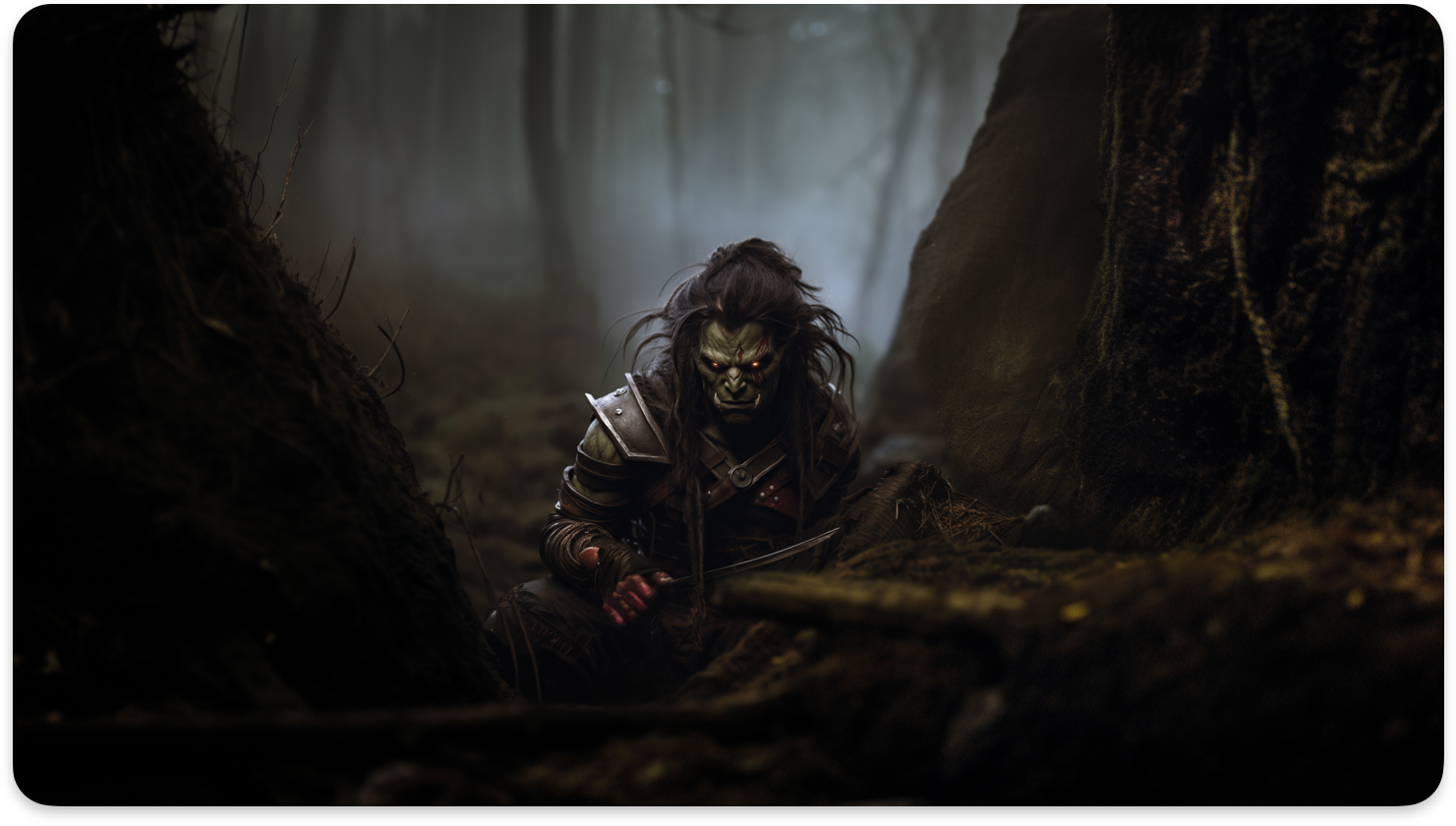 "I stare into my prey's eyes as they falter. Their terror lingers, seasoning the feast."
"I stare into my prey's eyes as they falter. Their terror lingers, seasoning the feast."
These agile orcs master the art of stealth and guile, flourishing in roles as hunters, scavengers, rogues, and assassins. Cloaked in shadows, they dance with the forest’s secrets, stalking prey (and enemies) with precision and striking from the veil of darkness.
Forgefires of Destiny: Blacksmiths and Artisans
 “Driving the hammer’s blows, our hands weld each Blood Triangle in steel.”
“Driving the hammer’s blows, our hands weld each Blood Triangle in steel.”
Within the tribe’s beating heart lies the forge, tended by skilled blacksmiths and artisans. With sweat and skill, they shape weapons, armor, and tools that resonate with the ancestral fire of their people. Each piece carries a history, a legacy, and the promise of victory.
Healers of Resilience: Healers and Herbalists
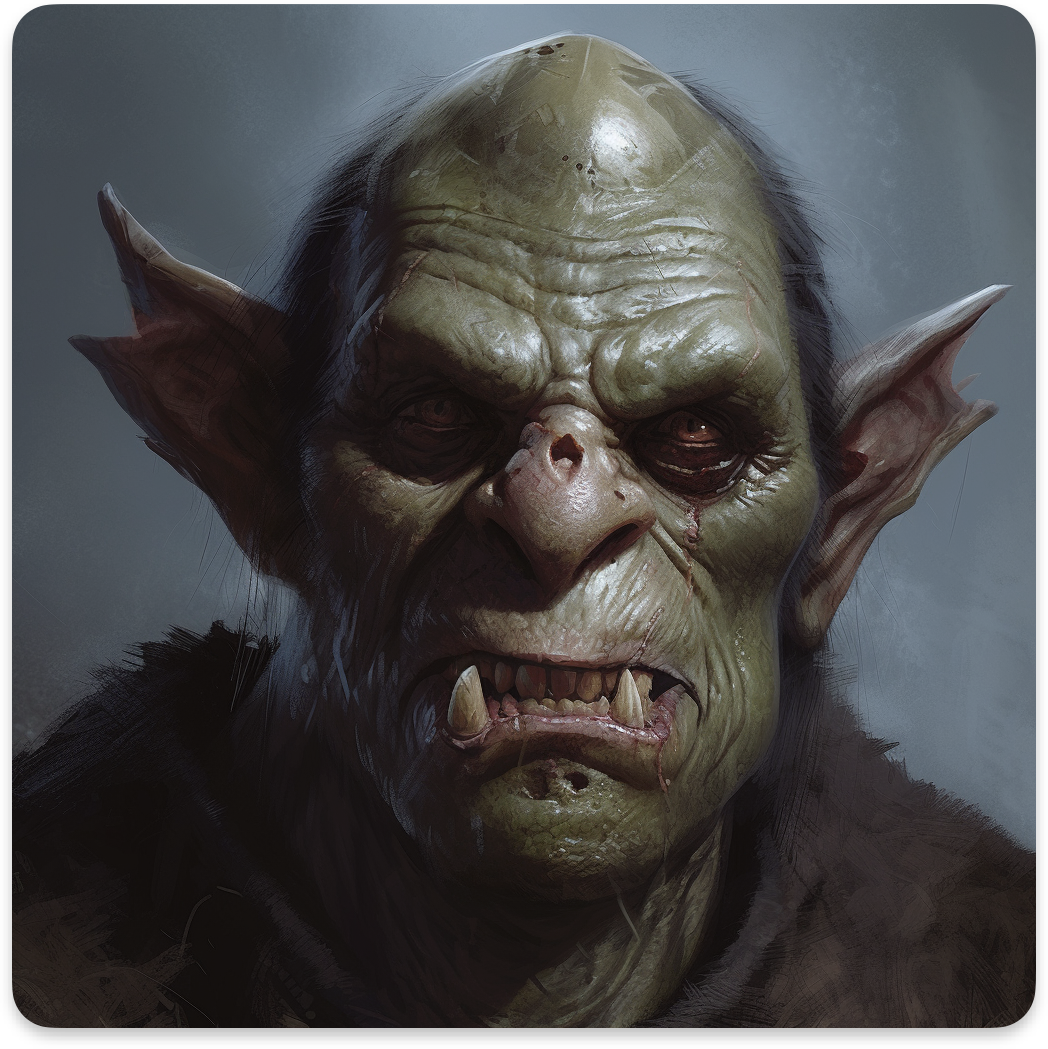 In the aftermath of battle, these healers mend the wounded, ensuring the resilience of the tribe. With herbs and salves, they nurse warriors back to health, embodying the spirit of unwavering strength.
In the aftermath of battle, these healers mend the wounded, ensuring the resilience of the tribe. With herbs and salves, they nurse warriors back to health, embodying the spirit of unwavering strength.
Reapers: Ranchers, Farmers and Gatherers - A tireless
The reapers bear testament to the tireless labor of these orcs, nurturing crops and gathering forest treasures. Meat, fruits, and grains sustain both body and spirit, binding the tribe to the land they call home. The larger camps maintain yards and glades of livestock from chickens, pigs, goats, and even steer.
Generations in Unity: Families and Children
Within familial bonds, the next generation blossoms, nurtured on tales of valor and unity. These children, snarling-laughter echoing through the tribe, are seeds that will grow into future warriors, carrying forth the tribe’s legacy.
Silent Echoes: The Lost Tribe’s Fading Faith
 “Ever silent, Gruumsh’s strength is a lie. The tribe washes away Gruumsh’s betrayal with the blood of the feeble.”
After the annihilation of the mountain orcs by the drow, The Lost Tribe greatly resented [Gruumsh and the other orc gods](https://forgottenrealms.fandom.com/wiki/Orc_pantheon). The orc pantheon seemed totally absent from the struggle with the drow. With the male leadership and shamans killed by the drow, The Lost Tribe slowly lost reason to worship the orc pantheon. Eventually, the tribe lost all faith in any divine orc. As if to prove that the orc gods abandoned them, nothing has been heard from the those gods since.
“Ever silent, Gruumsh’s strength is a lie. The tribe washes away Gruumsh’s betrayal with the blood of the feeble.”
After the annihilation of the mountain orcs by the drow, The Lost Tribe greatly resented [Gruumsh and the other orc gods](https://forgottenrealms.fandom.com/wiki/Orc_pantheon). The orc pantheon seemed totally absent from the struggle with the drow. With the male leadership and shamans killed by the drow, The Lost Tribe slowly lost reason to worship the orc pantheon. Eventually, the tribe lost all faith in any divine orc. As if to prove that the orc gods abandoned them, nothing has been heard from the those gods since.
The Lost have a reverence for the forest, but to say they worship the forest would be incorrect. The orcs see the forest as a force on its own, but more often a weapon, as one saying goes: “the forest finds blood just as quick as steel.” There is no denying the magical energy of the forest, which the rare orc druid harnesses. But the orcs have an utter lack of faith in anything spiritual.
Strength, valor, and survival are the only three things the Lost can be said to “worship.” As the orc saying goes: “the orc that listens to the gods’ lies shows their fear to face the flesh and bone standing before them.”
A popular Lost Tribe children’s bed time story
Qrald the One Fang told me this one night after I’d plied the Red Whisper with enough golden mead to lay an army of dwarves low.
In the old days when our tribe was settling in the Elderwood, a triangle found a hidden cave where the orcs here long before us and long gone worshiped Gruumsh. As nights turned to weeks, one of the triangle Rina was consumed by the stories of Gruumsh she had witnessed in the shrine. Each night, she secretly ventured back to the shrine alone, breaking her Blood Triangle in secret. So long did she turn her mind to Gruumsh the one-eyed, that she honored him in the old way by gouging out her own eye.
That same night, while she felt the witless ecstasy of One-Eye, a group of marauding drow attacked her camp. The drow destroyed three triangles, leaving only her own broken Blood Triangle. Unknowing of the consequence of her betrayal, Rina stumbled back to camp, weak from her pride in Gruumsh. She witnesses the drow slay her blood kin, draining their necks like stupid hogs. Each was strong as any member of the Lost. But, as only two, weak as an elf child’s bones.
Rina was enraged at the cowardly slaughter of her blood kin, but more so, her own fault in breaking the triangle. As the drow surrounded her for the kill, she yelled out in her weak voice, beseeching Gruumsh’s aid. The drow softly chuckled, it is said.
Her stance changed to a warriors’, crouched down, her hands of iron around her brute sword. As she licked the blood trickling from her enraged eye socket she said “Do you hear it, vile elves? There is no answer from the lies of Gruumsh. There is only answer from my steel" and slaughtered the drow single-handedly.
Thus we say: “the orc that sees with one eye drinks the blood of their triangle.”
It is said that the nine skulls that adorn the Blood Matriak’s throne are those of the slain drow.
Lost Tribe Sayings
With the code at the core of the Tribes essence, they each know and use hundreds of sayings, frequently as if to guide their thoughts and, thankfully, for those outside the tribe, make their intentions and thoughts clear.
- Poetry is the shield of the weak.
- Talk of dreams is talk of trash.
- The weak interrupt with words, the strong interrupt with blades.
- A compliment oft hides a knife.
- Talk of oneself is a distraction from talk of your enemy.
- When you show one who complains their entrails, they have but one complaints left.
- The enemy’s blade culls the weak, clearing a way for the strong to answer.
- Screamed or whispered, what is said before steel slices is meaningless.
- Mercy’s touch leaves a blade.
- Do not ask questions of the Matriark unless her reply is the last thing you wish to hear.